Dye Dale, O`neill Robert. The road to victory: From Pearl Harbor to Okinawa
Подождите немного. Документ загружается.

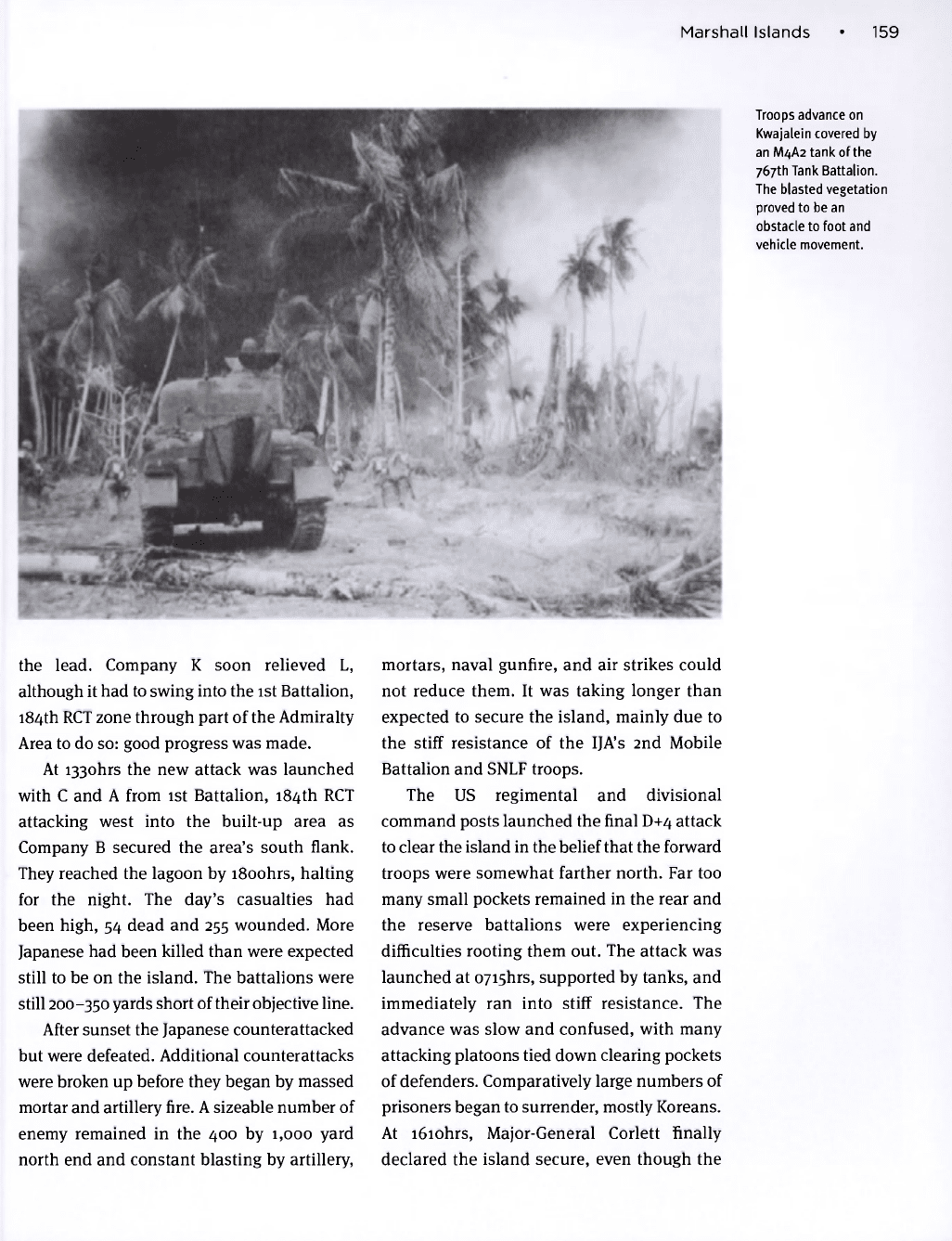
Marshall Islands • 159
Troops advance on
Kwajalein covered by
an M4A2 tank of the
767th Tank Battalion.
The blasted vegetation
proved to be an
obstacle to foot and
vehicle movement.
the lead. Company K soon relieved L,
although it had to swing into the 1st Battalion,
184th RCT zone through part of the Admiralty
Area to do so: good progress was made.
At i33ohrs the new attack was launched
with C and A from 1st Battalion, 184th RCT
attacking west into the built-up area as
Company B secured the area's south flank.
They reached the lagoon by i8oohrs, halting
for the night. The day's casualties had
been high, 54 dead and 255 wounded. More
Japanese had been killed than were expected
still to be on the island. The battalions were
still 200-350 yards short of their objective line.
After sunset the Japanese counterattacked
but were defeated. Additional counterattacks
were broken up before they began by massed
mortar and artillery fire. A sizeable number of
enemy remained in the 400 by 1,000 yard
north end and constant blasting by artillery,
mortars, naval gunfire, and air strikes could
not reduce them. It was taking longer than
expected to secure the island, mainly due to
the stiff resistance of the IJA's 2nd Mobile
Battalion and SNLF troops.
The US regimental and divisional
command posts launched the final D+4 attack
to clear the island in the belief that the forward
troops were somewhat farther north. Far too
many small pockets remained in the rear and
the reserve battalions were experiencing
difficulties rooting them out. The attack was
launched at 07ishrs, supported by tanks, and
immediately ran into stiff resistance. The
advance was slow and confused, with many
attacking platoons tied down clearing pockets
of defenders. Comparatively large numbers of
prisoners began to surrender, mostly Koreans.
At i6iohrs, Major-General Corlett finally
declared the island secure, even though the
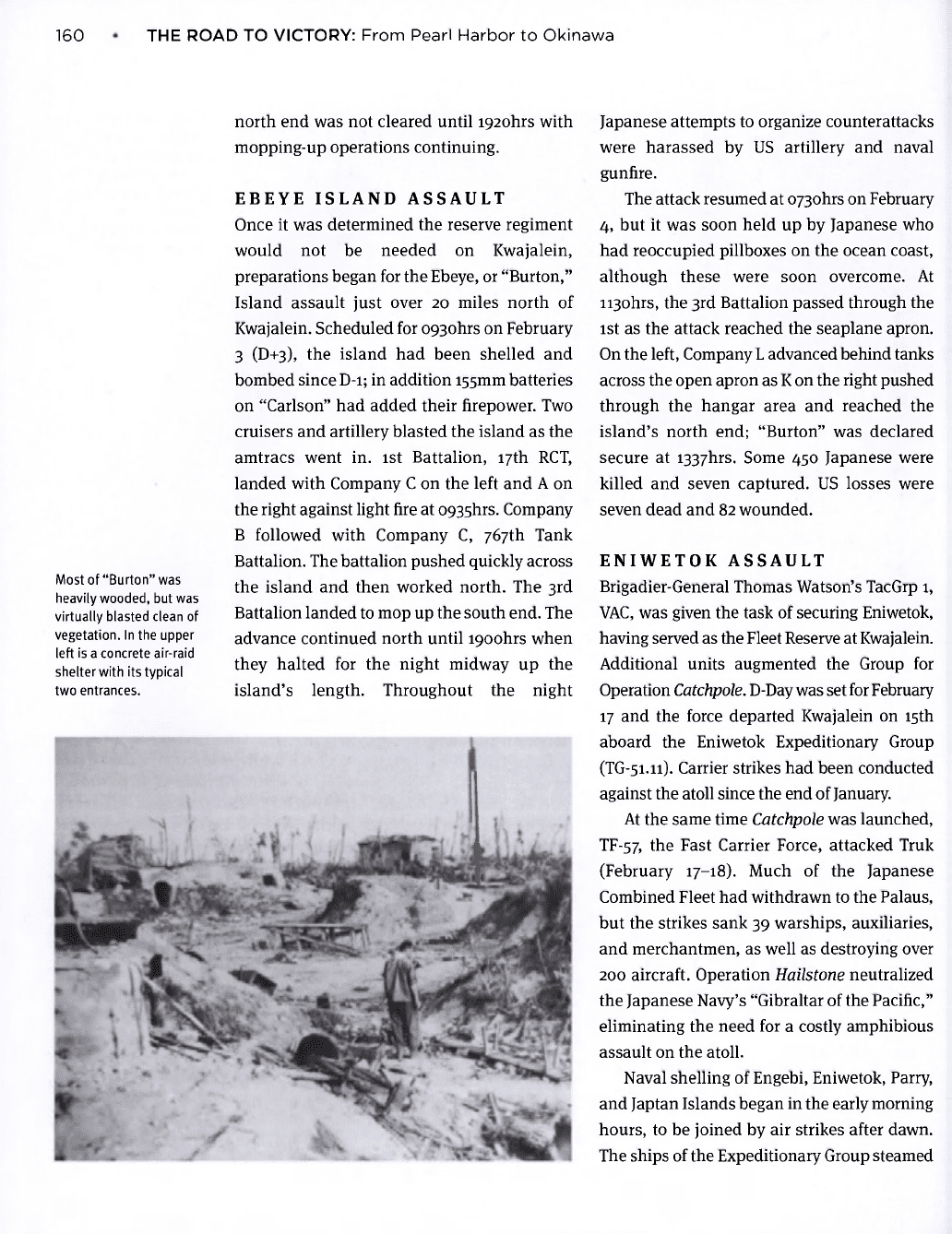
160 •
THE ROAD TO VICTORY: From Pearl Harbor to Okinawa
north end was not cleared until i92ohrs with
mopping-up operations continuing.
Most of "Burton" was
heavily wooded, but was
virtually blasted clean of
vegetation. In the upper
left is a concrete air-raid
shelter with its typical
two entrances.
EBEYE ISLAND ASSAULT
Once it was determined the reserve regiment
would not be needed on Kwajalein,
preparations began for the Ebeye, or "Burton,"
Island assault just over 20 miles north of
Kwajalein. Scheduled for 0930hrs on February
3 (D+3), the island had been shelled and
bombed since D-i; in addition 155mm batteries
on "Carlson" had added their firepower. Two
cruisers and artillery blasted the island as the
amtracs went in. 1st Battalion, 17th RCT,
landed with Company C on the left and A on
the right against light fire at 0935hrs. Company
B followed with Company C, 767th Tank
Battalion. The battalion pushed quickly across
the island and then worked north. The 3rd
Battalion landed to mop up the south end. The
advance continued north until i900hrs when
they halted for the night midway up the
island's length. Throughout the night
Japanese attempts to organize counterattacks
were harassed by US artillery and naval
gunfire.
The attack resumed at 0730hrs on February
4, but it was soon held up by Japanese who
had reoccupied pillboxes on the ocean coast,
although these were soon overcome. At
H3ohrs, the 3rd Battalion passed through the
1st as the attack reached the seaplane apron.
On the left, Company L advanced behind tanks
across the open apron as K on the right pushed
through the hangar area and reached the
island's north end; "Burton" was declared
secure at i337hrs. Some 450 Japanese were
killed and seven captured. US losses were
seven dead and 82 wounded.
ENIWETOK ASSAULT
Brigadier-General Thomas Watson's TacGrp 1,
VAC, was given the task of securing Eniwetok,
having served as the Fleet Reserve at Kwajalein.
Additional units augmented the Group for
Operation Catchpole.
D-Day
was set for February
17 and the force departed Kwajalein on 15th
aboard the Eniwetok Expeditionary Group
(TG-51.11). Carrier strikes had been conducted
against the atoll since the end of January.
At the same time Catchpole was launched,
TF-57, the Fast Carrier Force, attacked Truk
(February 17-18). Much of the Japanese
Combined Fleet had withdrawn to the Palaus,
but the strikes sank 39 warships, auxiliaries,
and merchantmen, as well as destroying over
200 aircraft. Operation Hailstone neutralized
the Japanese Navy's "Gibraltar of the Pacific,"
eliminating the need for a costly amphibious
assault on the atoll.
Naval shelling of Engebi, Eniwetok, Parry,
and Japtan Islands began in the early morning
hours, to be joined by air strikes after dawn.
The ships of the Expeditionary Group steamed

Marshall Islands • 161
An American plane
sweeps overhead to
strafe the enemy hidden
in their coral trenches.
A group of Marines
lie prone in the sand
peppering the Japanese
across smoking
No-Man's Land with rifle
fire. (Bettmann/Corbis)
single file through two passages in broad
daylight, three battleships, three cruisers,
15 destroyers, one sub-chaser, four
minesweepers, seven attack-transports, two
attack cargo-transports, six cargo ships, two
destroyer-transports, two tugs, an LSD, and
nine LSTs. Four escort carriers, their screening
destroyers, and auxiliaries remained outside
the lagoon. A fleet carrier and two light
carriers provided additional support. One
US Navy officer remarked that it was "one of
the most thrilling episodes that I witnessed
during the entire war."
All three main landings were led by
Company A, 708th Amphibian Tank Battalion.
The 708th Amphibian Tractor Battalion
provided the troop amtracs. The separate 22nd
Marines under Colonel John T. Walker would
take on most of the workload. Colonel Russell
G. Ayers' 106th Infantry, detached from the 27th
Infantry Division, and with its 2nd Battalion
still on Majuro, would back up the Marines.
Eniwetok's neighboring Islands,
February 17-18 (D-Day-D+i)
As the larger warships blasted the main
islands, destroyers shot up "Camellia" and
"Canna" to the southeast of Engebi. Elements
of Amphibious Reconnaissance Company,
VAC, were landed by amtrac on "Camellia" at
i32ohrs and on "Canna" at i33ohrs. Finding
them unoccupied, they secured them by
i400hrs on D-Day. "Zinnia" was secured by the
17 Company D (Scout), 4th Tank Battalion, as
were four other islets west of Engebi in the
early morning of D+i to prevent the enemy
escaping from Engebi. There had been a great
deal of confusion during the positioning of
ships for this phase, but it was nonetheless
accomplished on schedule.
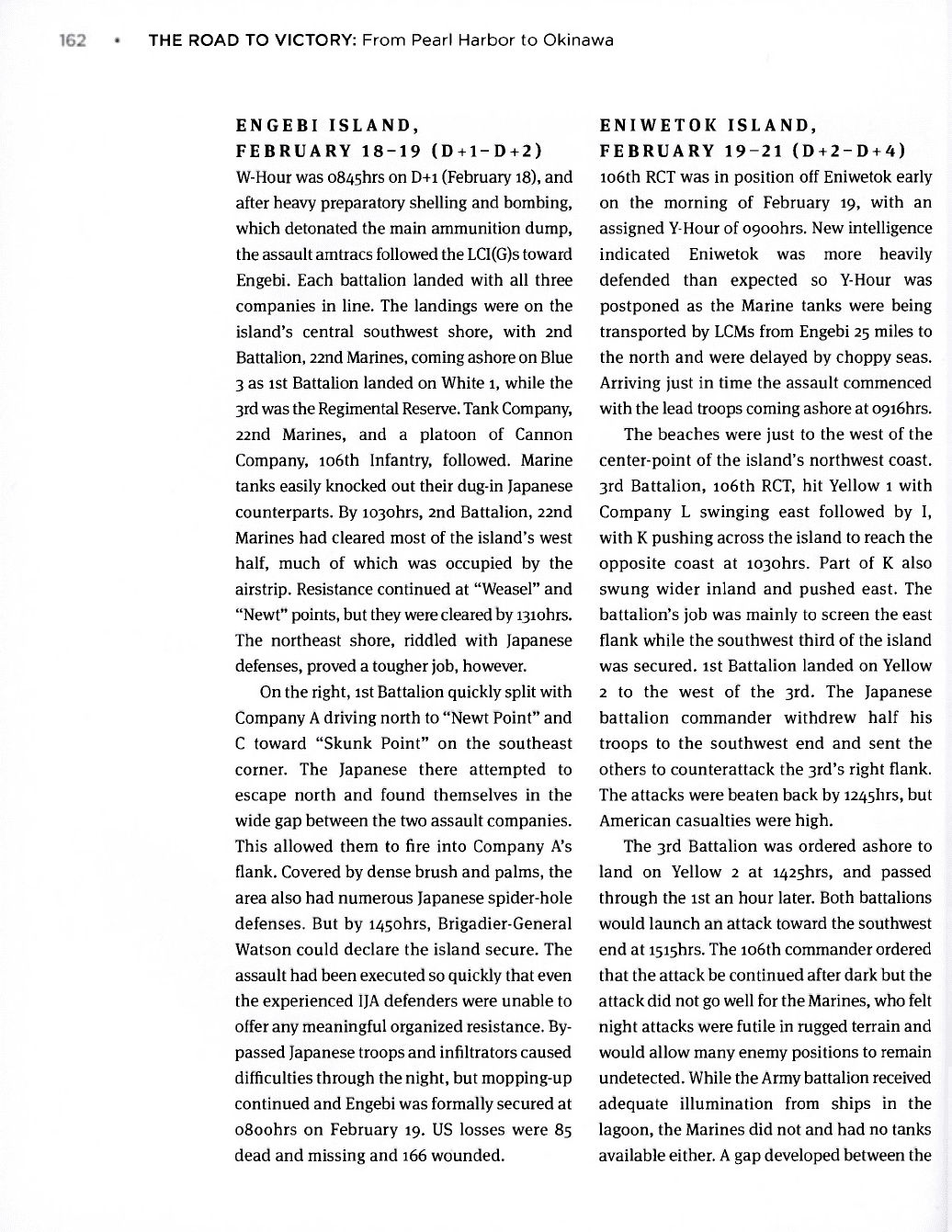
266 • THE ROAD TO VICTORY: From Pearl Harbor to Okinawa
ENGEBI ISLAND,
FEBRUARY 18-19 (D+l-D
+
2)
W-Hour was o845hrs on D+i (February 18), and
after heavy preparatory shelling and bombing,
which detonated the main ammunition dump,
the assault amtracs followed the LCI(G)s toward
Engebi. Each battalion landed with all three
companies in line. The landings were on the
island's central southwest shore, with 2nd
Battalion, 22nd Marines, coming ashore on Blue
3 as 1st Battalion landed on White 1, while the
3rd was the Regimental Reserve. Tank Company,
22nd Marines, and a platoon of Cannon
Company, 106th Infantry, followed. Marine
tanks easily knocked out their dug-in Japanese
counterparts. By io3ohrs, 2nd Battalion, 22nd
Marines had cleared most of the island's west
half, much of which was occupied by the
airstrip. Resistance continued at "Weasel" and
"Newt" points, but they were cleared by i3iohrs.
The northeast shore, riddled with Japanese
defenses, proved a tougher job, however.
On the right, 1st Battalion quickly split with
Company A driving north to "Newt Point" and
C toward "Skunk Point" on the southeast
corner. The Japanese there attempted to
escape north and found themselves in the
wide gap between the two assault companies.
This allowed them to fire into Company A's
flank. Covered by dense brush and palms, the
area also had numerous Japanese spider-hole
defenses. But by i45ohrs, Brigadier-General
Watson could declare the island secure. The
assault had been executed so quickly that even
the experienced IJA defenders were unable to
offer any meaningful organized resistance. By-
passed Japanese troops and infiltrators caused
difficulties through the night, but mopping-up
continued and Engebi was formally secured at
o8oohrs on February 19. US losses were 85
dead and missing and 166 wounded.
ENIWETOK ISLAND,
FEBRUARY 19-21 (D+2-D + 4)
106th RCT was in position off Eniwetok early
on the morning of February 19, with an
assigned Y-Hour of ogoohrs. New intelligence
indicated Eniwetok was more heavily
defended than expected so Y-Hour was
postponed as the Marine tanks were being
transported by LCMs from Engebi 25 miles to
the north and were delayed by choppy seas.
Arriving just in time the assault commenced
with the lead troops coming ashore at 09i6hrs.
The beaches were just to the west of the
center-point of the island's northwest coast.
3rd Battalion, 106th RCT, hit Yellow 1 with
Company L swinging east followed by I,
with K pushing across the island to reach the
opposite coast at i030hrs. Part of K also
swung wider inland and pushed east. The
battalion's job was mainly to screen the east
flank while the southwest third of the island
was secured. 1st Battalion landed on Yellow
2
to the west of the 3rd. The Japanese
battalion commander withdrew half his
troops to the southwest end and sent the
others to counterattack the 3rd's right flank.
The attacks were beaten back by
1245IUS,
but
American casualties were high.
The 3rd Battalion was ordered ashore to
land on Yellow 2 at i425hrs, and passed
through the 1st an hour later. Both battalions
would launch an attack toward the southwest
end at lsishrs. The 106th commander ordered
that the attack be continued after dark but the
attack did not go well for the Marines, who felt
night attacks were futile in rugged terrain and
would allow many enemy positions to remain
undetected. While the Army battalion received
adequate illumination from ships in the
lagoon, the Marines did not and had no tanks
available either. A gap developed between the
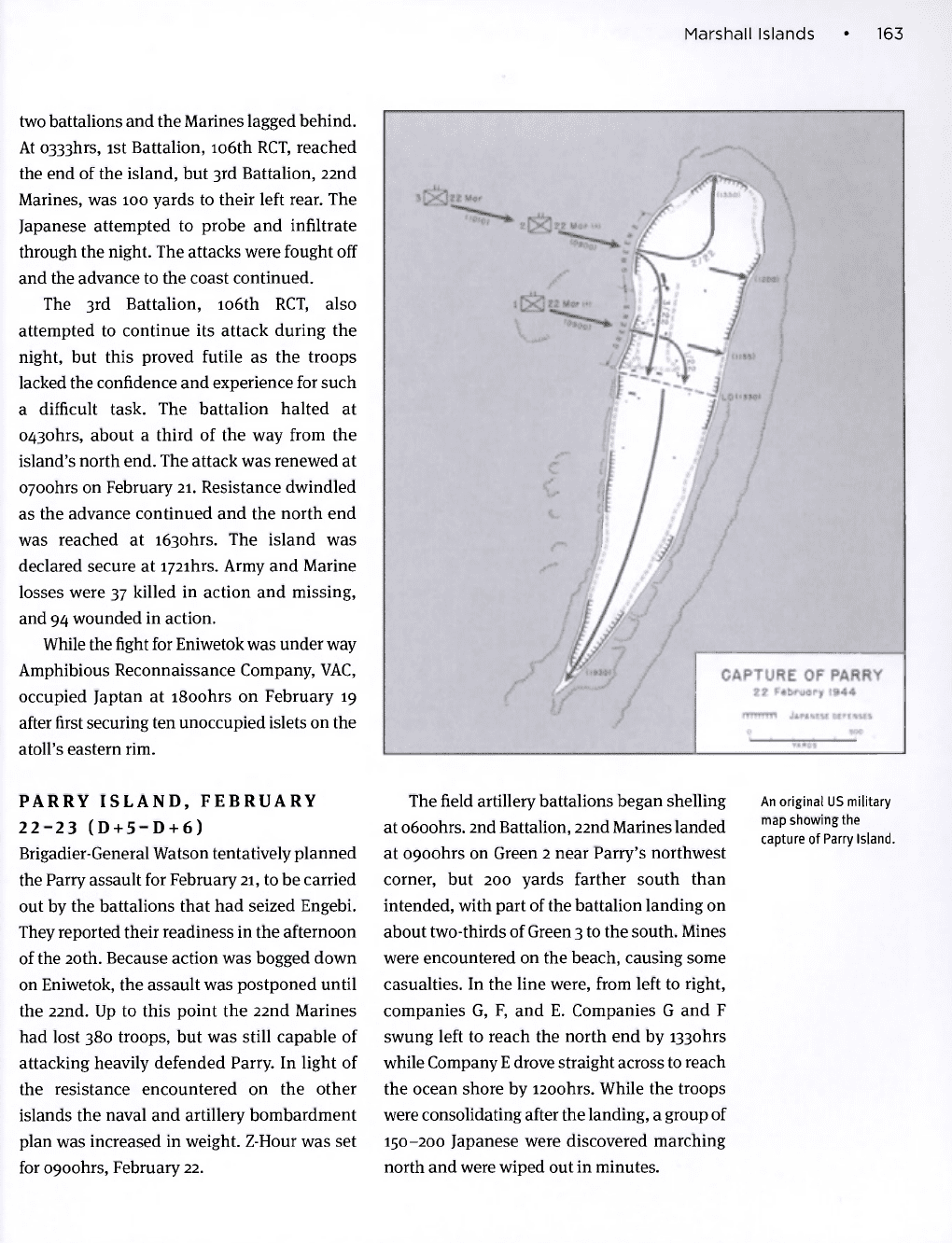
Marshall Islands • 163
two battalions and the Marines lagged behind.
At 0333hrs, ist Battalion, 106th RCT, reached
the end of the island, but 3rd Battalion, 22nd
Marines, was 100 yards to their left rear. The
Japanese attempted to probe and infiltrate
through the night. The attacks were fought off
and the advance to the coast continued.
The 3rd Battalion, 106th RCT, also
attempted to continue its attack during the
night, but this proved futile as the troops
lacked the confidence and experience for such
a difficult task. The battalion halted at
0430hrs, about a third of the way from the
island's north end. The attack was renewed at
oyoohrs on February 21. Resistance dwindled
as the advance continued and the north end
was reached at i63ohrs. The island was
declared secure at i72ihrs. Army and Marine
losses were 37 killed in action and missing,
and 94 wounded in action.
While the fight for Eniwetok was under way
Amphibious Reconnaissance Company, VAC,
occupied Japtan at i8oohrs on February 19
after first securing ten unoccupied islets on the
atoll's eastern rim.
PARRY ISLAND, FEBRUARY
22-23 (D
+
5- D + 6)
Brigadier-General Watson tentatively planned
the Parry assault for February 21, to be carried
out by the battalions that had seized Engebi.
They reported their readiness in the afternoon
of the 20th. Because action was bogged down
on Eniwetok, the assault was postponed until
the 22nd. Up to this point the 22nd Marines
had lost 380 troops, but was still capable of
attacking heavily defended Parry. In light of
the resistance encountered on the other
islands the naval and artillery bombardment
plan was increased in weight. Z-Hour was set
for 0900hrs, February 22.
The field artillery battalions began shelling An original
US
military
at o6oohrs. 2nd Battalion, 22nd Marines landed
map show
j
ng the
capture of Parry Island.
at 0900hrs on Green 2 near Parry's northwest
corner, but 200 yards farther south than
intended, with part of the battalion landing on
about two-thirds of Green 3 to the south. Mines
were encountered on the beach, causing some
casualties. In the line were, from left to right,
companies G, F, and E. Companies G and F
swung left to reach the north end by i33ohrs
while Company E drove straight across to reach
the ocean shore by i200hrs. While the troops
were consolidating after the landing, a group of
150-200 Japanese were discovered marching
north and were wiped out in minutes.
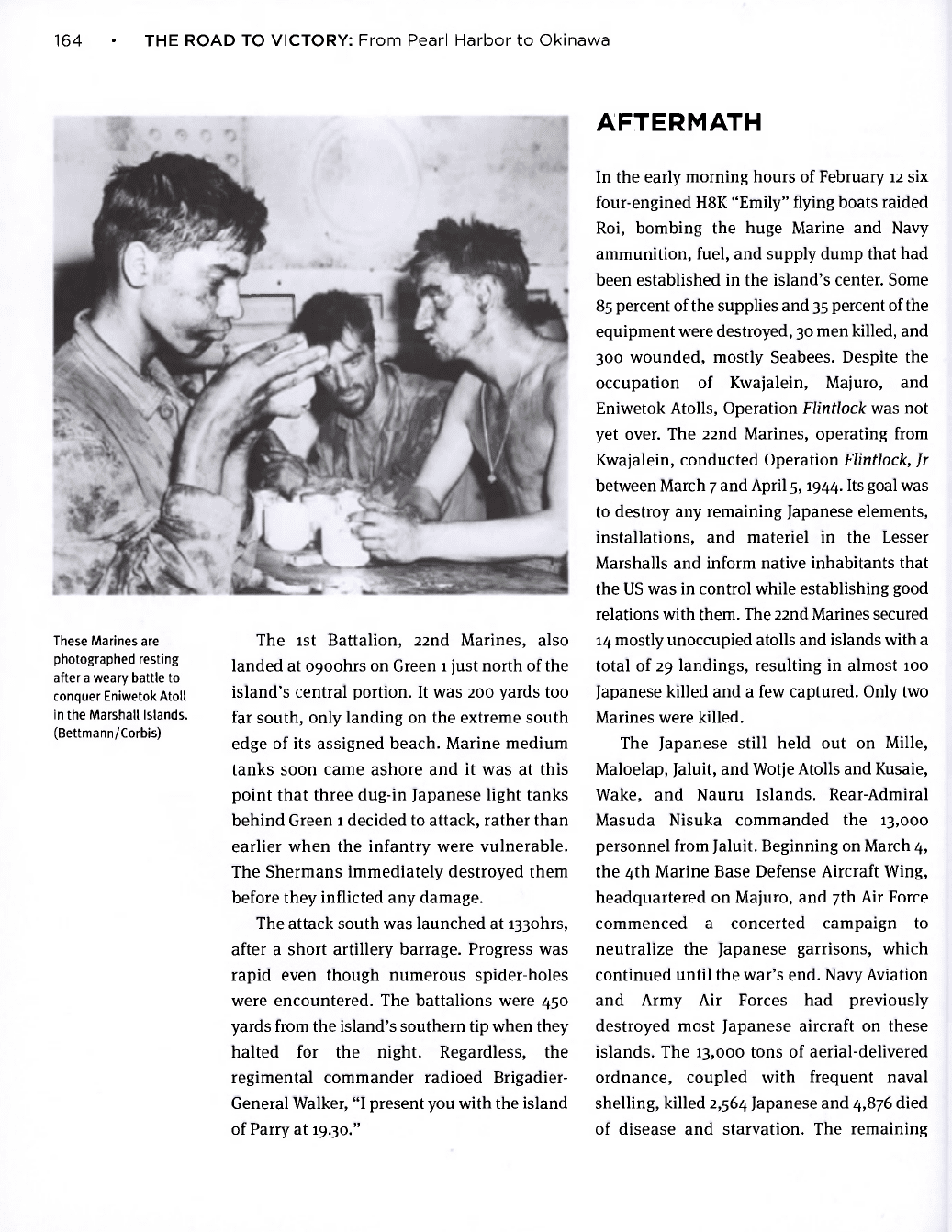
164 • THE ROAD TO VICTORY: From Pearl Harbor to Okinawa
These Marines are
photographed resting
after a weary battle to
conquer Eniwetok Atoll
in the Marshall Islands.
(Bettmann/Corbis)
The ist Battalion, 22nd Marines, also
landed at 0900hrs on Green 1 just north of the
island's central portion. It was 200 yards too
far south, only landing on the extreme south
edge of its assigned beach. Marine medium
tanks soon came ashore and it was at this
point that three dug-in Japanese light tanks
behind Green 1 decided to attack, rather than
earlier when the infantry were vulnerable.
The Shermans immediately destroyed them
before they inflicted any damage.
The attack south was launched at i33ohrs,
after a short artillery barrage. Progress was
rapid even though numerous spider-holes
were encountered. The battalions were 450
yards from the island's southern tip when they
halted for the night. Regardless, the
regimental commander radioed Brigadier-
General Walker, "I present you with the island
of Parry at 19.30."
AFTERMATH
In the early morning hours of February 12 six
four-engined H8K "Emily" flying boats raided
Roi, bombing the huge Marine and Navy
ammunition, fuel, and supply dump that had
been established in the island's center. Some
85 percent of the supplies and 35 percent of the
equipment were destroyed, 30 men killed, and
300 wounded, mostly Seabees. Despite the
occupation of Kwajalein, Majuro, and
Eniwetok Atolls, Operation Flintlock was not
yet over. The 22nd Marines, operating from
Kwajalein, conducted Operation Flintlock, Jr
between March 7 and April 5,1944. Its goal was
to destroy any remaining Japanese elements,
installations, and materiel in the Lesser
Marshalls and inform native inhabitants that
the US was in control while establishing good
relations with them. The 22nd Marines secured
14 mostly unoccupied atolls and islands with a
total of 29 landings, resulting in almost 100
Japanese killed and a few captured. Only two
Marines were killed.
The Japanese still held out on Mille,
Maloelap, Jaluit, and Wotje Atolls and Kusaie,
Wake, and Nauru Islands. Rear-Admiral
Masuda Nisuka commanded the 13,000
personnel from Jaluit. Beginning on March 4,
the 4th Marine Base Defense Aircraft Wing,
headquartered on Majuro, and 7th Air Force
commenced a concerted campaign to
neutralize the Japanese garrisons, which
continued until the war's end. Navy Aviation
and Army Air Forces had previously
destroyed most Japanese aircraft on these
islands. The 13,000 tons of aerial-delivered
ordnance, coupled with frequent naval
shelling, killed 2,564 Japanese and 4,876 died
of disease and starvation. The remaining
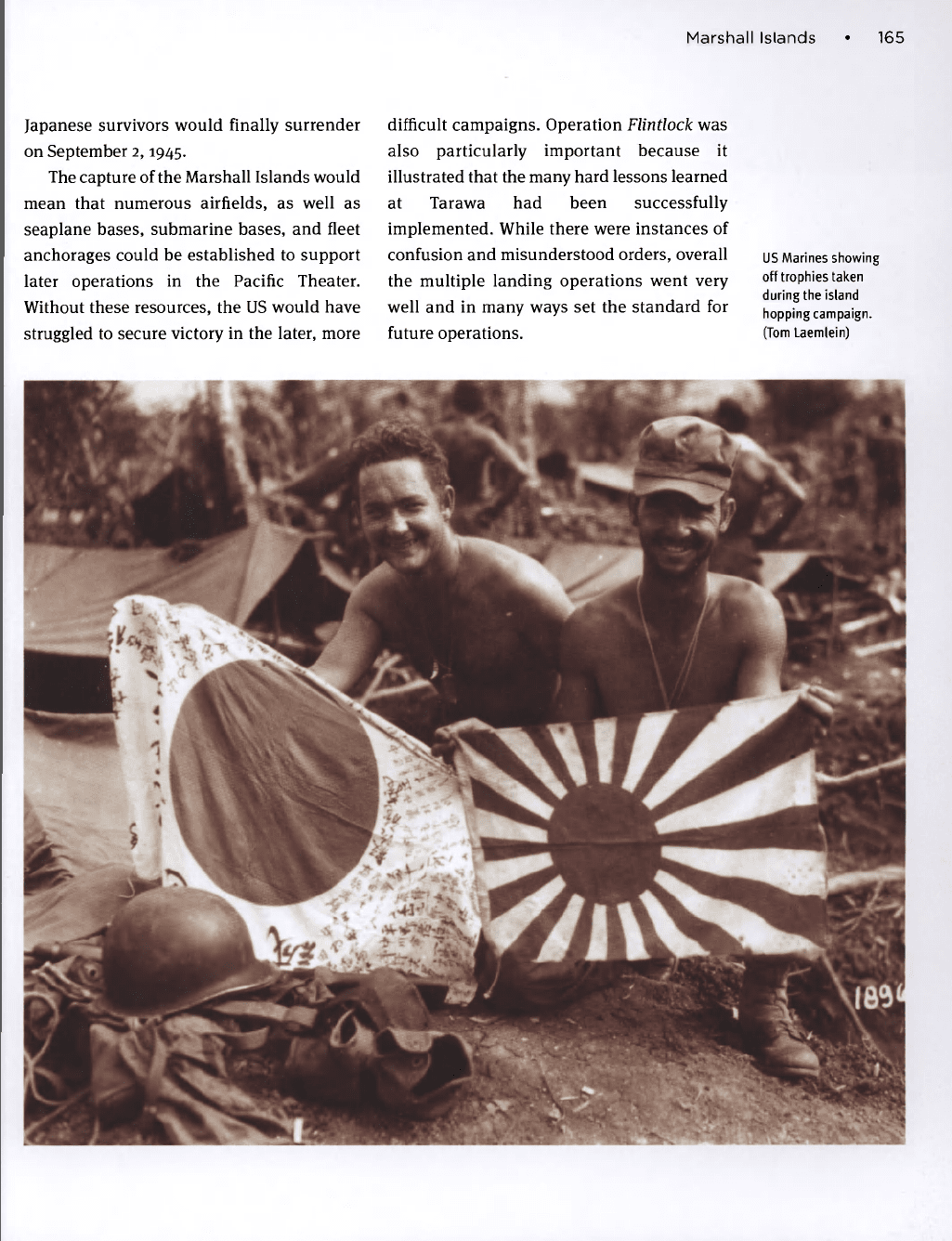
Marshall Islands • 165
Japanese survivors would finally surrender
on September 2,1945.
The capture of the Marshall Islands would
mean that numerous airfields, as well as
seaplane bases, submarine bases, and fleet
anchorages could be established to support
later operations in the Pacific Theater.
Without these resources, the US would have
struggled to secure victory in the later, more
difficult campaigns. Operation Flintlock was
also particularly important because it
illustrated that the many hard lessons learned
at Tarawa had been successfully
implemented. While there were instances of
confusion and misunderstood orders, overall
the multiple landing operations went very
well and in many ways set the standard for
future operations.
US Marines showing
off trophies taken
during the island
hopping campaign.
(Tom Laemlein)
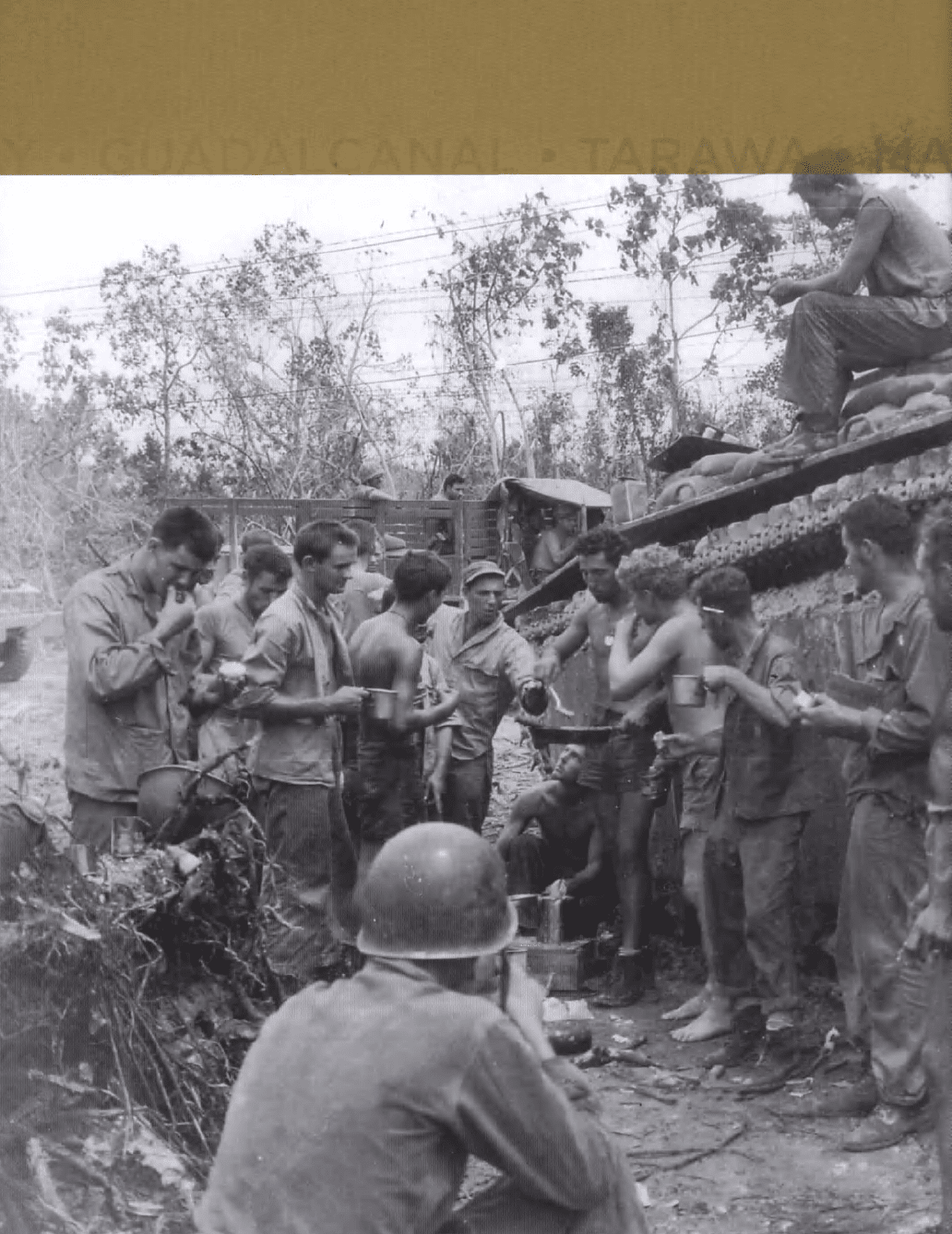
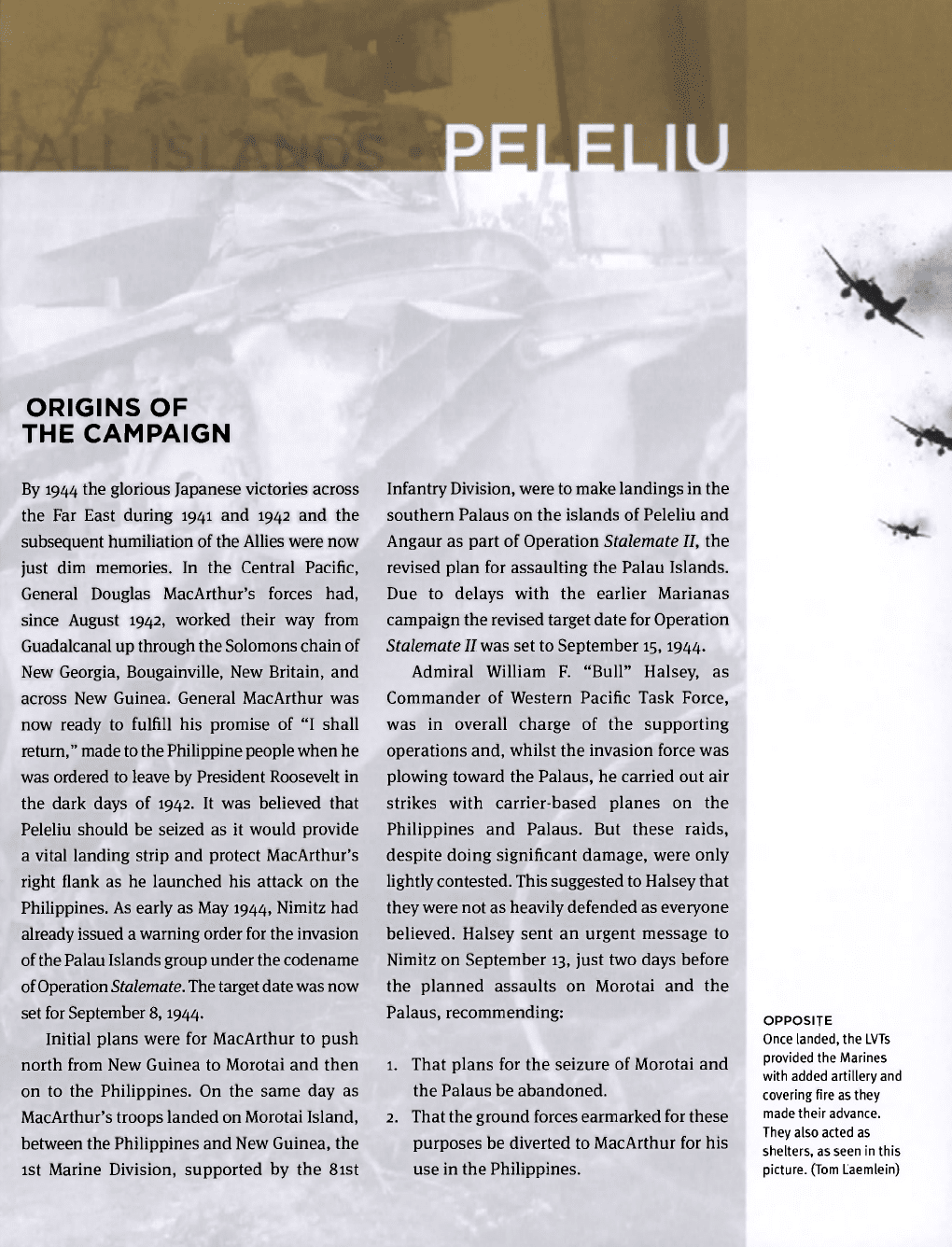
ORIGINS OF
THE CAMPAIGN
By 1944 the glorious Japanese victories across
the Far East during 1941 and 1942 and the
subsequent humiliation of the Allies were now
just dim memories. In the Central Pacific,
General Douglas MacArthur's forces had,
since August 1942, worked their way from
Guadalcanal up through the Solomons chain of
New Georgia, Bougainville, New Britain, and
across New Guinea. General MacArthur was
now ready to fulfill his promise of "I shall
return," made to the Philippine people when he
was ordered to leave by President Roosevelt in
the dark days of 1942. It was believed that
Peleliu should be seized as it would provide
a vital landing strip and protect MacArthur's
right flank as he launched his attack on the
Philippines. As early as May 1944, Nimitz had
already issued a warning order for the invasion
of the Palau Islands group under the codename
of Operation Stalemate. The target date was now
set for September 8,1944.
Initial plans were for MacArthur to push
north from New Guinea to Morotai and then
on to the Philippines. On the same day as
MacArthur's troops landed on Morotai Island,
between the Philippines and New Guinea, the
1st Marine Division, supported by the 81st
Infantry Division, were to make landings in the
southern Palaus on the islands of Peleliu and
Angaur as part of Operation Stalemate II, the
revised plan for assaulting the Palau Islands.
Due to delays with the earlier Marianas
campaign the revised target date for Operation
Stalemate II was set to September 15,1944.
Admiral William F. "Bull" Halsey, as
Commander of Western Pacific Task Force,
was in overall charge of the supporting
operations and, whilst the invasion force was
plowing toward the Palaus, he carried out air
strikes with carrier-based planes on the
Philippines and Palaus. But these raids,
despite doing significant damage, were only
lightly contested. This suggested to Halsey that
they were not as heavily defended as everyone
believed. Halsey sent an urgent message to
Nimitz on September 13, just two days before
the planned assaults on Morotai and the
Palaus, recommending:
1. That plans for the seizure of Morotai and
the Palaus be abandoned.
2. That the ground forces earmarked for these
purposes be diverted to MacArthur for his
use in the Philippines.
OPPOSITE
Once landed, the LVTs
provided the Marines
with added artillery and
covering fire as they
made their advance.
They also acted as
shelters, as seen in this
picture. (Tom Laemlein)
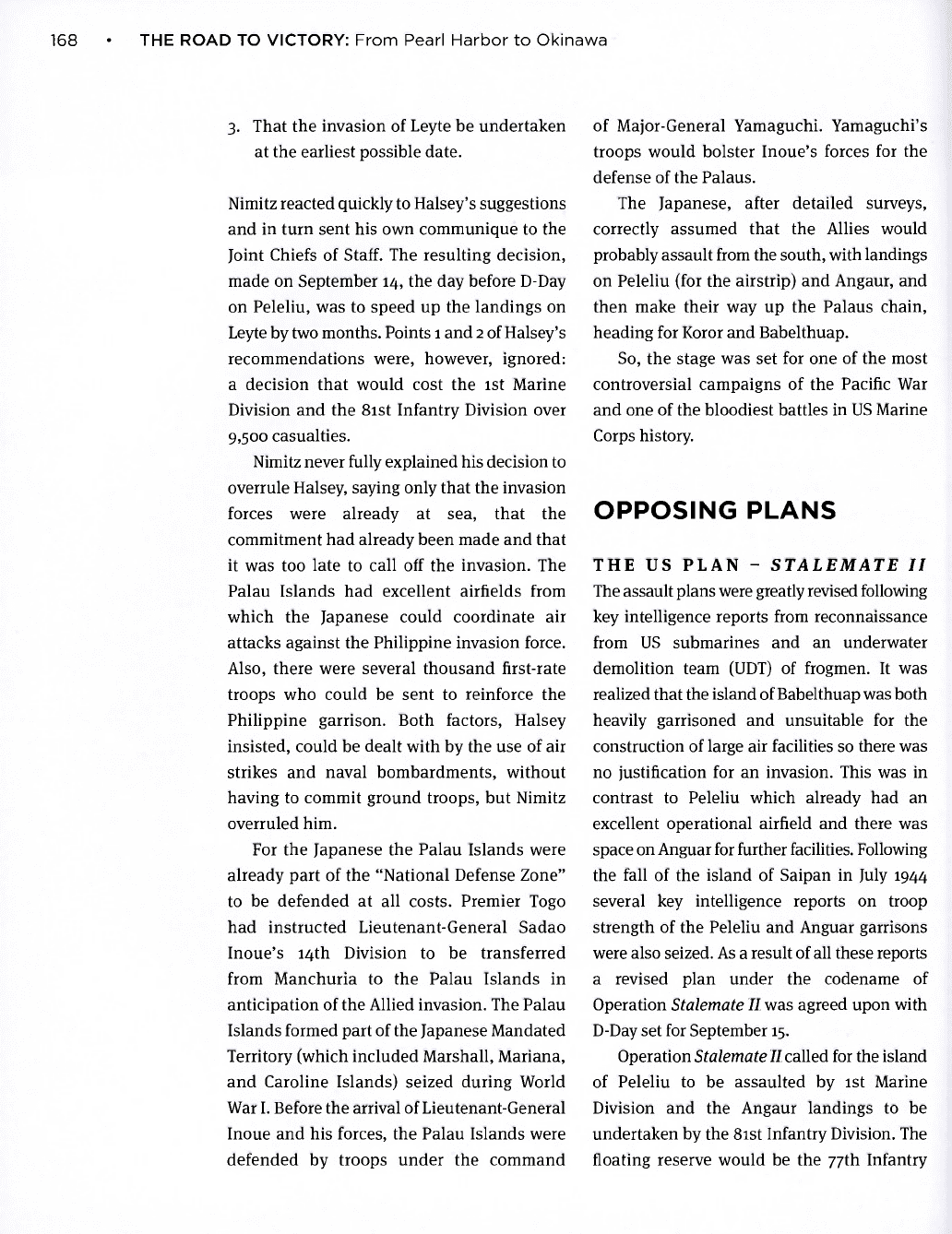
168 • THE ROAD TO VICTORY: From Pearl Harbor to Okinawa
3. That the invasion of Leyte be undertaken
at the earliest possible date.
Nimitz reacted quickly to Halsey's suggestions
and in turn sent his own communique to the
Joint Chiefs of Staff. The resulting decision,
made on September 14, the day before D-Day
on Peleliu, was to speed up the landings on
Leyte by two months. Points 1 and 2 of Halsey's
recommendations were, however, ignored:
a decision that would cost the 1st Marine
Division and the 81st Infantry Division over
9,500 casualties.
Nimitz never fully explained his decision to
overrule Halsey, saying only that the invasion
forces were already at sea, that the
commitment had already been made and that
it was too late to call off the invasion. The
Palau Islands had excellent airfields from
which the Japanese could coordinate air
attacks against the Philippine invasion force.
Also, there were several thousand first-rate
troops who could be sent to reinforce the
Philippine garrison. Both factors, Halsey
insisted, could be dealt with by the use of air
strikes and naval bombardments, without
having to commit ground troops, but Nimitz
overruled him.
For the Japanese the Palau Islands were
already part of the "National Defense Zone"
to be defended at all costs. Premier Togo
had instructed Lieutenant-General Sadao
Inoue's 14th Division to be transferred
from Manchuria to the Palau Islands in
anticipation of the Allied invasion. The Palau
Islands formed part of the Japanese Mandated
Territory (which included Marshall, Mariana,
and Caroline Islands) seized during World
War I. Before the arrival of Lieutenant-General
Inoue and his forces, the Palau Islands were
defended by troops under the command
of Major-General Yamaguchi. Yamaguchi's
troops would bolster Inoue's forces for the
defense of the Palaus.
The Japanese, after detailed surveys,
correctly assumed that the Allies would
probably assault from the south, with landings
on Peleliu (for the airstrip) and Angaur, and
then make their way up the Palaus chain,
heading for Koror and Babelthuap.
So, the stage was set for one of the most
controversial campaigns of the Pacific War
and one of the bloodiest battles in US Marine
Corps history.
OPPOSING PLANS
THE US PLAN - STALEMATE II
The assault plans were greatly revised following
key intelligence reports from reconnaissance
from US submarines and an underwater
demolition team (UDT) of frogmen. It was
realized that the island of Babelthuap was both
heavily garrisoned and unsuitable for the
construction of large air facilities so there was
no justification for an invasion. This was in
contrast to Peleliu which already had an
excellent operational airfield and there was
space on Anguar for further facilities. Following
the fall of the island of Saipan in July 1944
several key intelligence reports on troop
strength of the Peleliu and Anguar garrisons
were also seized. As a result of all these reports
a revised plan under the codename of
Operation Stalemate II was agreed upon with
D-Day set for September 15.
Operation Stalemate II called for the island
of Peleliu to be assaulted by 1st Marine
Division and the Angaur landings to be
undertaken by the 81st Infantry Division. The
floating reserve would be the 77th Infantry
